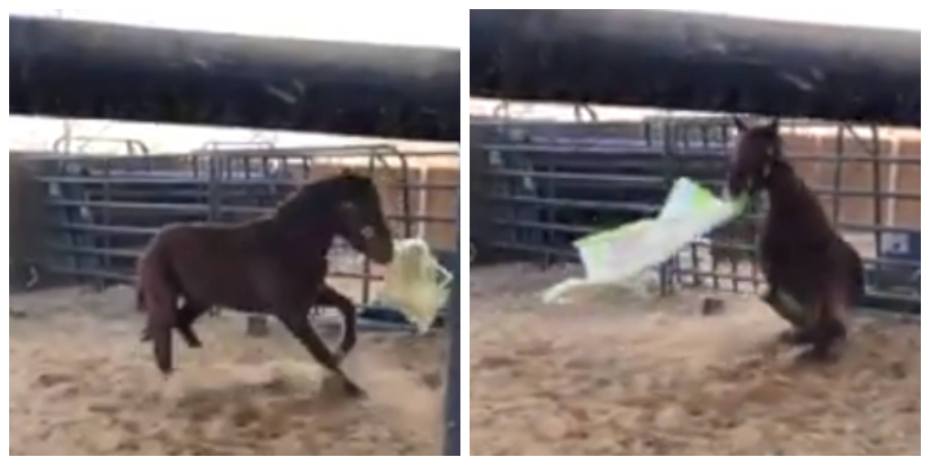Videos of horses doing “funny” things are often going viral. The video below is no exception. Three days after posting, this video received 163k views, with many mixed opinions.
Removing the sound and concentrating directly on the actions of the horse we can start to see what’s really going on.
Curiosity – a normal trait that enables horses to learn.
Curiosity is essential for learning and growth. Anyone who has been around younger horses will soon realize that some horses are naturally more curious than others. Curiosity drives the horse to figure out new things to work out if those things are scary or not.
Playful or scared?
Every rider and horse owner has at some point experienced a bolting or panicking horse. More experienced horsey people will be able to recognize the difference between a playful horse and scared horse. Learning to spot the difference is very important and can change the way we train horses in the future.
The nervous system
The horse’s autonomic nervous system (the part of the nervous system in charge of bodily functions not consciously directed) is further divided into the parasympathetic and the sympathetic nervous system.
The parasympathetic nervous system takes over when the horse is calm, doing things like resting and digesting. When it is active, the heart rate is lower, the breathing is calm and the horse often exhibits calming soft blows, sighing and yawning. Eating can activate the parasympathetic nervous system and this is why it is important for horses to eat regularly and have access to forage during times of stress such as trailering and at shows/clinics etc.
At the other end of the spectrum we have the sympathetic nervous system which kicks in when stress levels are high and the fight and flight response is activated. We’ve all witnessed horses calmly munching on their hay when all of the sudden they lift their head, stiffen their ears and neck to focus on something they see in the distance. Have you ever noticed how at that point they stop eating? Very often that will happen with hay still hanging out of their mouth. This occurs because their jaw can actually lock down in preparation for running away. In this moment the horse’s nervous system switches from parasympathetic to sympathetic. During this moment the heart rate will rise, ready to provide muscles with the blood supply needed for a run.
‘Funny video’ explained
In this particular video we see the switching from one aspect of the nervous system to the other in a very obvious manner. The horse on the video is curious about the tarp, approaches it and bites it, at which point his flight response kicks in, his jaw clamps down and the temporo-mandibular joint locks.
Pictures 1 and 2 above show the horse in a flight or fight state – his head is high and tense, he is running backwards and sideways, away from the scary object. Picture 3 shows the horse that has managed to part with the scary object and is now analysing the situation coming out of the fight or flight response and starting to relax.
When horses, driven by natural curiosity, pick things up with their mouths, their autonomic nervous system will decide what will happen next. If the item is considered scary the sympathetic nervous system will be activated, the jaw can sometimes lock down and the item is then trapped in the horse’s mouth. This however does not happen with every horse and every interaction, it only happens occasionally. With this particular video and situation the horse is exhibiting signs of activation of the sympathetic system. The horse’s movements are stiff as he is trying to get away from the tarp, which is a source of fear and stress. Once the bag ends up under the front legs of the horse, he is able to stomp on it and remove it from his mouth, enabling him to escape the item. Once he escapes the tarp, he reassess the situation and decides if it is life threatening or if it is worth investigating the item again.
The owner of the horse told us that this horse later returned to the tarp, picked it up again and will now happily play with it. As the object became familiar, his body language changed and chasing the tarp turned into a play. He will still toss his head and run around with the tarp, but he will do it in a relaxed manner, showing signs of play, not fear.
The curiosity of the horse outweighed the fear of the tarp and he learnt that even though the object was scary in the beginning, it was not life threatening.
As responsible horse owners we should learn how to read the body language of our horses and learn to differentiate between playful and fearful behavior, as this will enable us to make better training decisions.





